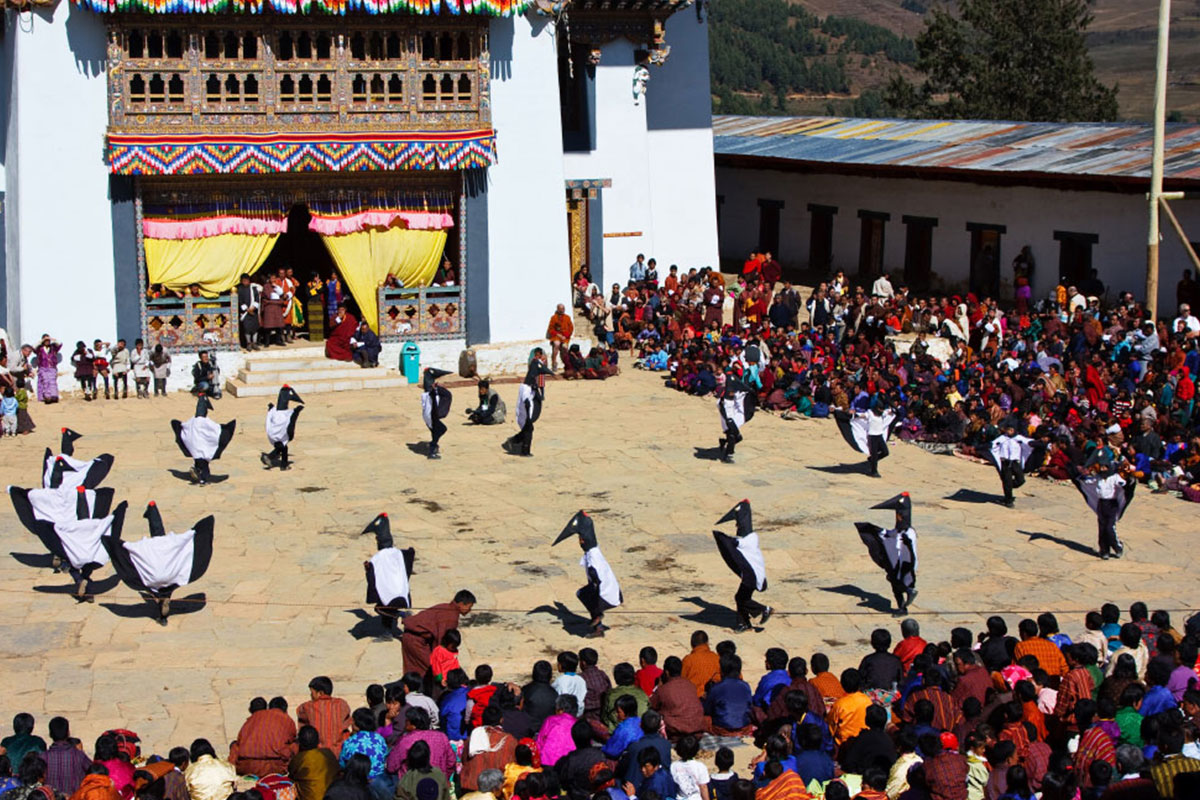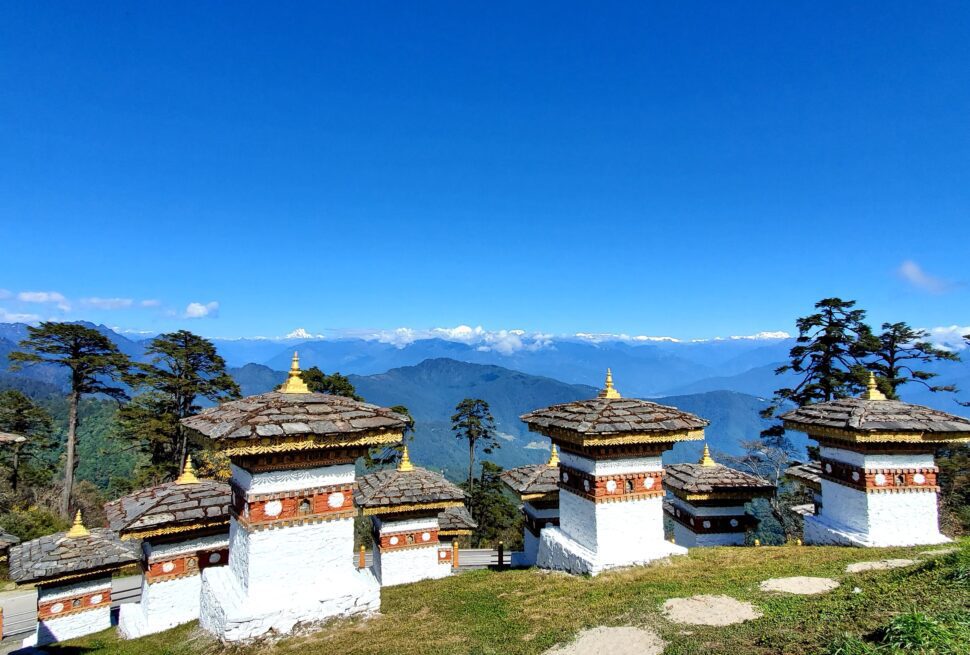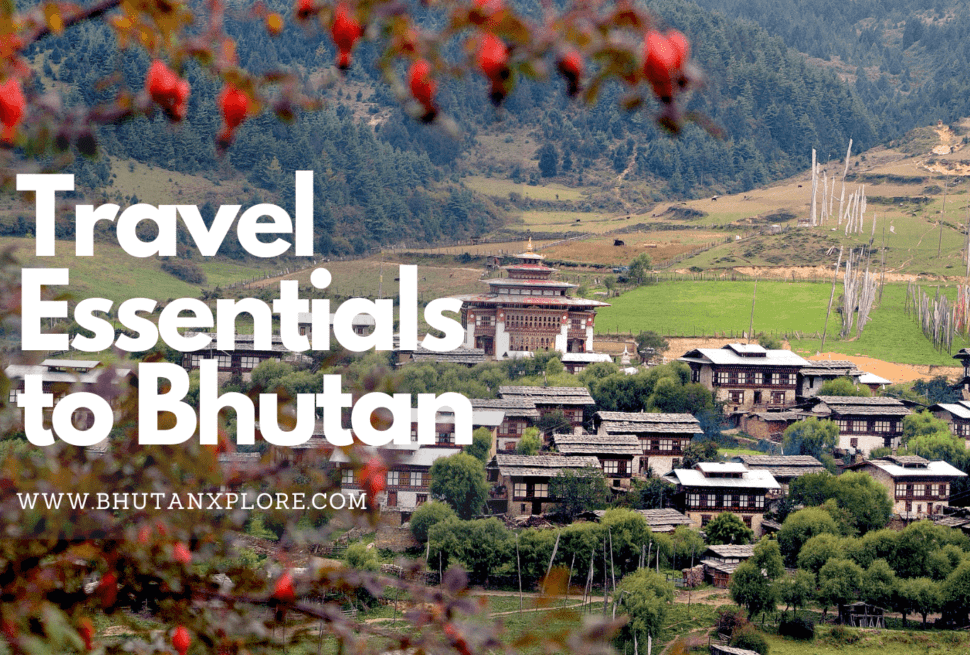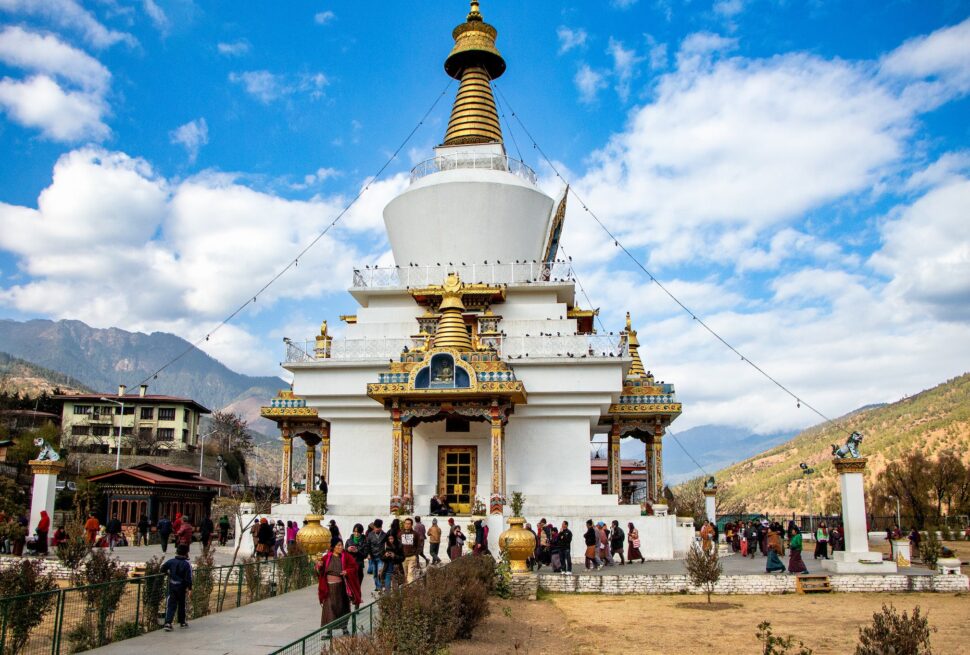Bumthang
Bumthang is home to some of the Kingdom's most ancient and precious Buddhist sites. The district is sub-divided into the four blocks of Chhoekhor, Chhume, Tang and Ura, all of which are broad and gentle valleys carved by ancient glaciers. The wide and scenic valleys of Bumthang attract a large number of tourists each year, and elevations in this region range from 2,400 to 6,000 meters above the sea level. At 3,100 meters, Ura is the highest of the main inhabited valleys. The district center is Jakar, dominated by the sparkling Jakar Dzong or "Castle of the White Bird". The Chamkhar river which flows through Jakar is famous for its healthy stock of trout, protected by recent injunctions against fishing because of the numerous sacred shrines in the district.
The Jakar Dzong or "Castle of the White Bird" was built in 1677. It was later renamed Yuelay Namgyel Dzong. Today the Dzong functions as the administrative and the religious seat of the district. In Chamkhar valley one also comes across the old Wangdichholing Palace built in 1857 by the Trongsa Penlop, Jigme Namgyel. It later became the primary palaces of the first and the second kings of Bhutan.
One of the oldest temples in Bhutan, Jampa Lhakhang was built in 659 A.D. by Tibetan King Songtsen Gampo to pin down the left knee of a giant ogress whose body lay across the Himalayas. The inner shrine of the temple houses an exquisite image of Jowo Jampa, the Buddha of the Future, also know as Maitreya.
The Kencho Sum Lhakhang was originally built in the 7th century but later restored by Terton Pema Lingpa in the 15th century. The three sacred Buddha statues which grace the lhakhang's main shrine are said to have miraculously flown there from Khini in Kurtoe, a region further east.
The Lhodrak Kharchu Dratshang built by Namkhai Nyingpo is located on a forested slope overlooking Chamkhar town.
Tak Rimochen takes its name from the vertical tiger-stripes like print on the face of the cliff where Guru Padmasambhava is said to have meditated in the 8th century A.D. Established by the great Dzogchen master, Longchen Rabjampa, the Tharpaling Goemba in Chumey valley was one of the main seats of the Nyingmapa school of Buddhism. It dates back to the 15th century.
The temple complex at Kurjey is an important place of pilgrimage for devout Bhutanese as it was built around a rock on which Guru Padmasambhava left an imprint of his body while meditating there in the 8th century. The name Kurjey means sacred body imprint. The rock around which the temple grew came to be known as Dragmar Dorje Tshegpa (the Red Cliff of the Diamond of Long Life). A wall with 108 choetens was built around the complex by Her Majesty Kesang Choden Wangchuck in 1984.
Choejedrak Lhakhang is among the many holy sites that was identified and blessed by Guru Padmasambhava. According to legend, the Guru came on a flying tigress and left remarkable imprints on the rocks that one can see to this day around the temple. For instance, one can see a cubit length footprint of the Guru, and the footprints of the legendary flying tigress that the Guru rode to Choejedrak from Taktshang in Paro in the fearsome form of Dorji Drolo, one of his eight sacred manifestations. The temple we see today was founded by Gyalwa Lolaypa in the 12th century. One of the most treasured relics at Choejedrak is the skull of one of the Guru's consorts.
Remarkable saints and teachers known as Tertons, or "Treasure Revealers", play a crucial role in the Himalayan Buddhist tradition. Inspired by sacred visions they unearth and interpret sacred spiritual texts and relics hidden in the 8th century by Guru Padmasambhava. The Tamzhing lhakhang was founded by one of the foremost of those Treasure Revealers, Terton Pema Lingpa, in the year 1501 A.D. Later, the temple became the seat of the successive Sungtruls or "Speech Reincarnations" of Terton Pema Lingpa. The armory in the temple, also cast by Terton Pema Lingpa, is a testimony of the saint's renowned skill as a black-smith. Inside Tamzhing, one also comes across wall paintings by Pema Lingpa, and a throne that he built.
Thukten Shedrup Dargay Choling Goemba was co- founded by Dasho Gonpo Dorji and Doring Trulku Jamyang Kunzang, the third mind reincarnation of Terton Jigme Lingpa, in 1935. The temple serves as a Sheydra (monastic school) as well as a Drubda (meditation center).
Terton Dorji Lingpa built Decenphodrang temple over the ruins of the ancient Chakhar lhakhang, what was once a colossal nine-storied castle built with many layers of metal. While no remains of the original castle built by the King of Chakhar, or Sindhu Raja, are evident today, echoes of its old ties to the Chakhar Gyalpo (King) linger in the fact that the sacred Termas or "spiritual treasures" in the Dechcenphodrang temple are dedicated to Trashi Kheudron, his daughter, who is also revered as one of Guru Padmasambhava's mystical consorts.
Aside from devout Bhutanese pilgrims, these sacred shrines and temples of Bumthang today attract a considerable number of foreign visitors who come to experience some of the spiritual power of the region, as well as to enjoy the region's various annual festivals such as the Ura Yakchoe.
The main commercial hub of Bumthang is Chamkhar town. Besides its favorable location along the Lateral Route from West to East Bhutan-the highway passes right down the center of it-Chamkhar has also benefited from the growth of tourism. Many of the best tourist lodges in the region are to be found in the valley surrounding chamkhar. New and recent cottage industries in and around Chamkhar also include the fabrication of metal Bukharis (smokeless stoves), breweries, wineries, fruit products, and the ever popular Swiss Dairy Farm.
Known as Bumthaps, the original inhabitants of Bumthang speak Bumthangpaikha, a Tibeto-Burman language closely related to Bhutan's national language Dzongkha, and Khengkha, the language of the south central region of Zhemgang.
The regional cuisine of Bumthang includes buckwheat pancakes called Khooli and the buckwheat noodles known as Puta. Another well-loved specialty of the region is the chugo or hardened cheese cubes made from Yak milk. Rice cultivation was introduced to the region only recently and the former staple of Buckwheat still remains a strong presence in the local diet.
Bumthaps are renowned across the kingdom for their skill in weaving, especially of Yathra, which are hand spun of yak hair and sheep wool and woven on trestle looms in a vibrant pallete of colors and patterns. Another popular fabric from the region is the woolen Bumthap Mathra, check and plaid weavings popularly worn as ghos (men) and kiras (women) all across the country.
Lhuntse
Wedged like an upside down tooth in W the north-eastern corner of the kingdom, the ancient region of Kurtoe (or Lhuentse as it is known today) enjoys two auspicious connotations in the Bhutanese mind. First, it is considered the spiritual home of Bhutan's beloved kings, and second, it boasts some of the most sacred sites of pilgrimage in the country.
Geographically, Lhuentse is one of the remotest districts of Bhutan, with a population of about 15,400 scattered across its eight blocks. Located 77 kilometers from the nearest district, Mongar, the
Lhuentse Dzong was built in 1552 by Ngagi Wangchuk. The original structure was enlarged in 1656 and renamed Lhundub Rinchen Tse Dzong. Other important structures in the Kurtoe valley are the Choeje Nagtshang founded by Kuenga Wangpo, who was Terton Pema Lingpa's son, and the Dungkar Nagtshang, built by the Trongsa Penlop Jigme Namgyal, father of Gongsar Ugyen Wangchuck, the first king of Bhutan. The famed Singye Dzong, one of the most important sites of pilgrimage in Bhutan, is also to be found in the district.
Among the noble lineages to emerge from the Kurtoe region, the House of Dungkar was home to the Trongsa Penlop, Jigme Namgyal, progenitor of the Wangchuck dynasty. Similarly, the Choeje Nagtshang was the seat of Kuenga Wangpo, son of the great "Treasure Revealer" Terton Pema Lingpa.
The Kilung Lhakhang situated on a ridge overlooking the Kurichu river stands on the former site of the fortress of the Kilung Gyalpo, a regional chieftain who lived in ancient times. This temple houses a sacred chain mail that was once used, according to legend, to recapture a statue that miraculously flew away from the Lhuentse Dzong.
The Jangchubling Monastery is another significant religious building in the region that was founded in the 18th century by Choeje Pekar Jamtsho. In recent history, the monastery was under the patronage of the "Great Sixteenth" Karmapa Rangjung Rigpe Dorji (August 14, 1924-November 5, 1981), and the daughter of Bhutan's first King, Her Royal Highness Ashi Wangmo, who lived out the end of her days as a nun at the monastery.
The Khinyel Lhakhang was built in the 8th century and renovated by Terton Pema Lingpa in the 15th century.
The temple complex at Singye Dzong at an altitude of over 3,000 meters above the sea level is deemed sacred because Guru Padmasambhava meditated here during the 8th century.
The ethnic mosaic of the region is made up of the Kurtoep people who live in the upper valleys of the Kurichhu river, the Kurmed people who inhabit the valleys downstream, and the Khomapas and Tshanglas who are scattered throughout the rest of the district.
Linguistically, the region can be divided into four broad dialects. The Kurtoeps speak Kur tod pai Kha, which is similar to the Bumthang Kha, spoken in the Bumthang valley. The Kurmeds, who speak Cho Cha Nga Cha Kha, the Tshanglas, who speak the Tshangla Kha, and the Khomapas who speak Zala Kha.
Among the region's various ethnic groups, the Tshanglas are the most recent settlers, having migrated to the region during the late 19th and early 20th centuries in search of better land. They migrated from Pemagatshel district (further to the south east) and Dungsam Dewathang in the south, near the border with India.
The people of Lhuentse are mostly paddy farmers. They also grow maize, millet, barley, wheat, and buckwheat to supplement rice cultivation. Other agricultural produce from the region include potatoes and chilies.
Some of the best textile weavers in the Kingdom come from the Kurtoe region, and the exquisite Kishuthara, famed and treasured as women's kira all over Bhutan, comes from the Khoma village in Lhuentse.
For Kurtoep women the winter months are often solely dedicated to the weaving of textiles that are finding outlets in the many handicraft stores and tourist shops in the capital, Thimphu, supplementing household income. In another matter of pride for the region, the crafts people of Gangzur village, whose pottery work was well known in the past, are seeing a resurgence of their art today.
Many shamanic bon rituals add color to the cultural diversity of the region. The most significant, called Choedpas, include masked dance performances similar to the other major festivals of western and central Bhutan.
Kurtoeps are adept singers and the valleys often resound with the region's folk popular songs. The lyrical and wistful Kurtoepai Alo is a unique and a popular song sung by the people of upper Kurtoe, usually when friends and relatives are preparing to leave on long journeys.
Trongsa
S acred and temporal heart of the kingdom, the Trongsa district has a significant place i in Bhutanese history connected with the lineage of Bhutan's kings. This importance of the region is reflected today in the fact that the future king of Bhutan must first be instituted as the Trongsa Penlop, before assuming the throne. History also tells us that the father of the first king first received intimations of the illustrious future of his family in the Trongsa Dzong.
The region covers an area of 1,807 square kilometers, and is separated from the neighbouring districts by high mountain passes. It shares borders with Wangduephodrang to the west, Bumthang to the northeast, Zhemgang to the southeast and Sarpang to the south. The Trongsa district has five blocks and is home to about 261 Monpas, one of the ethnic inhabitants of the region. The Monpa people are believed to be among the oldest inhabitants of Bhutan. Originally hunter gatherers, Monpa tribals were formerly entirely dependent on the forest resources for their daily needs, but today community- based tourism is providing alternative sources of income and livelihood for the people and their crafts. Still, their respect for nature is reflected in their animistic spiritual traditions. A unique fabric woven from the nettle plant called Pagay provides the material for their dress.
Maize and rice constitute the staple food of the region and the largest ethnic group, called Trongsaps or Mangdips speak the Mangdipkha.
The Ta Dzong or "watch tower", which sits on a promontory above the town, was built by Chogyal Minjur Tempa in 1652. The tower has four observation points resembling Tag (Tiger), Seng (Lion), Chung (Garuda) and Druk (Dragon). Today it serves as a National Museum, monastic residence and a place of meditation.
The district also boasts palaces like Eundu Chholing in Langthel block and Thruepang in Nubi block. Eundu Chholing Palace was the winter residence of the First King, Ugyen Wangchuk, and Thruepang Palace was the birthplace of the Third King Jigme Dorji Wangchuk.
A large impressive stupa near Chendebji village built in the traditional Nepalese style was commissioned in 19th century by a Tibetan Lama called Shida. The structure stands over what is believed to be the remains of an evil spirit subjugated on the spot. The stupa is known today as Choeten Jarung Kashor.
In the 14th century, the Terton Dorji Lingpa discovered several treasures from the Jamba Lhakhang in Bumthang, and began preaching the teachings of Lama Kadue (a special ritual) and Dzogchen Tawa Lyongyang (another religious practice) in Trongsa. During that time, his main follower and disciple, Tshulthrim Namgyal, founded the Drala Goemba. Tshulthrim's son, Lopen Khentse Sheynyen, later renovated and enlarged the monastery.
The Kuenga Rabten Palace, located 23 kilometers south of Trongsa town, is historically significant as the winter home of the second King. The first floor was used to store food, the second as the living quarters of the royal attendants and the third floor housed the royal quarters and the King's private chapel.
Among the region's sacred monuments, the Nubji Lhakhang in Korphu commemorates the belief that Guru Padmasambhava meditated on the sacred spot while returning from Bumthang, on his way to India in the 8th century. The place was a battlefield in the war between King Sindhu Raja of Bumthang and King Naoche of Assam, and a holy rock on the spot marks a peace agreement brokered by the guru.
Trongsa is also well known in the country for its folk songs and dances, and some of the best traditional singers in the country come from this region. An exotic folkdance from the region called the "Nubi Zhey" is performed during special occasions such as the Tshechu festival and Bhutan's National Day. Buddhism and Bon practices coexist peacefully in the cultural lives of the region's people.
The Trongsaps speak the Mangdekha. The Monpas of the region, meanwhile, speak an endangered language called Mon Kha. The region's people are primarily subsistence cultivators, and their diet consists of maize and rice, millet and buckwheat. The Monpas are skilled craftsmen, especially using bamboo and cane.
The Jigme Singye Wangchuk National Park, located in the region, boasts several wildlife species like red panda, golden Langur, sambar, musk deer, Himalayan black bear, tiger, leopard and some 449 species of birds. The Mangde Chhu flows through the district, providing an important marker between the various sub-divisions of the region.
Wangdue Phodrang
Known as Sha or "east" to the Bhutanese, Wangduephodrang district is an importa important gateway to the far-flung corners of Bhutan. It shares borders with the districts of Trongsa and Bumthang in the east, Thimphu and Punakha in the west, Gasa in the north and Dagana, Sarpang and Tsirang in the south.
This 4,308 square-kilometer region, the second largest after Gasa, is divided into 15 blocks which are multi-lingual and multi-ethnic. It stretches from 800 meters to about 5,800 meters above the sea level, with a wide
range of climates. The southern extremes of the region are sub-tropical while the northern part has cool summers and cold winters with the far-north mostly under snow. The district receives an average annual rainfall of 1,000 mm.
Wangduephodrang district is rich in monasteries and Buddhist shrines. Dolung Goemba, in Khotokha, was built by the 2nd Je Khenpo Sonam Yozer towards the end of the 17th century after he found a peculiar rock with a hole through it. The chief abbot took the rock to be an auspicious relic and built the monastery to commemorate the sacred object. Other relics in the monastery include the mask of the Raksha, or "the bull-headed one" represented in the Raksha Mangchham masked dances.
The famed Gangtey monastery, also known as Gangtey Sanga Choeling Goemba, is located on a hill at approximately 2,800 meters above the sea level. The location offers a stunning view of the Phobjikha valley, home to endangered black-necked cranes. The monastery was founded by Je Kuenga Gyeltshen in 1613. The current emanation of Terton Pema Lingpa, the Gangtey Trulku, is the Chief Abbot of the monastery. Located on a ridge high above the Dangchu river, the Nyizergang Lhakhang was built by Terton Wugpa Lingpa in the 13th century. It was originally called Gedunchholing, and the main relic of the monastery is an object representing the Za (planetary deity) and a necklace with a bead of Za (rare knots of wood).
The Rinchenling Shedra is a monastic school in Khotokha. It was built on a site originally occupied by a temple built by Longchen Rabjam in the 14th century as one of the monasteries of the Lingchen Gyed (the eight vast plains)
An important site of pilgrimage in the region is Boe Langdra, associated with the subjugation of a local deity by Guru Padmasambhava in the 8th century AD. The Nye, or sacred site, remained unknown until it was discovered by Terton Dorji Lingpa. The 14th Je Khenpo Tenzin Namgyel (1775-81) restored the ruins to its religious significance.
Kubum Lhakhang, in Phobjikha valley, is a Bon temple built by Zhabdrung Tshenden Dulwa in the 13th century. The name is derived from the 100,000 images of the Bon founder Tonpa Shenrab painted in gold on the walls of the lhakhang. Radra Nekhang is the abode of a well known local deity, the Radra. The deity is reputed to supernaturally aid people who solicit his help, be it in battle, business, or the more mundane aspects of acquiring wealth and fame. Chungney Goemba, in Phangyul, founded in 1655 by Thinley Pelbar, a disciple of Zhabdrung Ngawang Namgyel, is another sacred monastery in the district.
Dargay Goemba in Chungsegang was built on the spot where Drukpa Kuenley (the Divine Madman) met Ashi Genzo, a famed beauty of the region. It began as a Drubdey or meditation centre used by Ngawang Drakpa, the son of Lam Ngawang Chogyal.
Wangduephodrang presents a rich ethnic and linguistic mosaic. Most speak Ngalongpakha, "language of the earliest risen", but in a localized patois form. Other languages of the region include Monkha, Lakha and Mangdekha.
A wide range of festivals are performed across the district. The most popular is the tshechu besides Nyilog (winter solstice), Lhabon, Bongko, and the recently introduced crane festival.
Wangdue is also known for archery games where local teams solicit the help of astrologers and local deities for victory. In Kashi and Nyisho, the unique tradition of playing archery wearing Patang (sword) continues to this day. The district is also acclaimed for its Lozey, an ornamental form of speech, which has been idealised in the "Ballad of Pemi Tshewang Tashi" and "Gaylong Sumdar Tashi".
The region is rich in natural resources with a diverse range of flora and fauna. About 65% of its area is covered by forest, a large part of which falls under the 1,300 km square Black Mountain National Park.
More than 40 species of mammals inhabit the lush forests of Wangduephodrang including rare species like tiger, red panda and leopard. Wangduephodrang can also be a birder's paradise with 391 species of birds frequenting the region, including rare and protected birds like the black-necked crane, the white-bellied heron and the spotted eagle.
The economically significant Basochu Phase I and II hydropower projects generate 64 MW of power, while Punatsangchu Projects, I and II, under construction will boost the regional economy further. The region is one of the biggest producers of slate.
Zhemgang
Zhemgang district is located in the south-central region of Bhutan and covers an area of about 2,126 square kilometers. It shares borders with Bumthang, Sarpang, Mongar and Samdrup Jongkhar districts. The district has traditionally been divided into three main regions called the Khengrig Namsum, or the "Sacred Realm of Three Hills". These are Upper Kheng (Chikor), Middle Kheng (Nangkor) and Lower Kheng (Tamachok/Matpala).
The climatic conditions vary significantly with warm and humid conditions in the south to cold temperate or moderate temperatures in the north. About 86% of the total area of Zhemgang is under forest cover, because of which the district is blessed with a rich biodiversity including no less than 22 endangered animal species among whom we find the endemic Golden Langur.
The region's people number about 26,000 inhabitants who live scattered over eight blocks and some 67 villages.
Zhemgang district is known as one of the last strongholds of non-Buddhist religious practices generally grouped under Bon. Nearly every locality has its own Bon priest known as the Bonpo. With the growing influence and reputation of the central monk body, the people today practice a combination of the old Bon religion and Buddhism.
The Khengpas, as the region's people are called, have preserved a rich culture, and folk songs such as Bu Moi Karmai Wangzom are sung by Kheng women during the region's annual cultivation of cotton. These folk songs are now in danger of being lost as the younger generations migrate to the urban area in search of non- agricultural employment.
Historical sites in Zhemgang include those built by the famous treasure revealer (Terton) Pema Lingpa in the 15th century. The Buli Lhakhang and the Tharpa Choeling Lhakhang are two such monuments. The Gomphu Lhakhang in Middle Kheng includes a sacred crematorium founded by Lama Shacha Yoezer believed to be sited over an area formerly occupied by a sacred lake.
While the Khengpas remain the main inhabitants of the region, other ethnic groups such as the Tshanglas, Bumthaps, Ngalongpas and Lhotshampas have also made their homes in the this rich and fertile region. Agriculture and animal husbandry are the main sources of livelihood for about 90% of the population and the most common form of cultivation involves the slash and burn technique called Tseri.
The main cash crop of the region is citrus mandarin (orange) and the staple diet is maize, rice and wheat. Some of the region's people are also well known for their skills in weaving cane products which are sold in other parts of the country. The mandarin oranges are exported to India and Bangladesh.
Khengpas are also skilled craftspeople and the region's most famous and nationally recognised products include Bangchungs (matted bamboo plates), Palangs (alcohol containers), Balaks (hats), Paris (mats), Zems (boxes), Aumbuli (small containers) and Bangkhaps (bamboo winnowers). The Khengpas are also skilled potters and make earthenware for cooking and distilling alcohol which were traded favorably in other parts of the country in the past for basic necessities such as salt, knives and baking powder. Khengpas live in traditional homes built from rock, mud and wood while in the more rural and remote interiors one also finds simpler dwellings fashioned from bamboo thatch and plantain leaves.
Zhemgang is one of the least developed districts. Most of the villages are situated in far-flung areas that take days to reach. Modern amenities such as schools and basic health units have sprung up in recent years and include the Yebilaptsa hospital established with the help of the Norwegian Santal Mission. The district is a gateway to the Royal Manas National Park, which has been recognised as a UNESCO World Heritage Site for its wealth of biodiversity.




